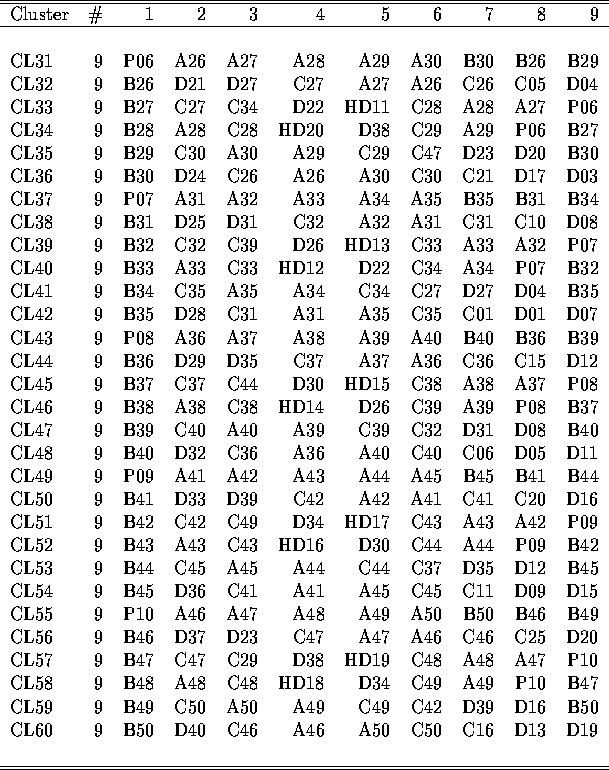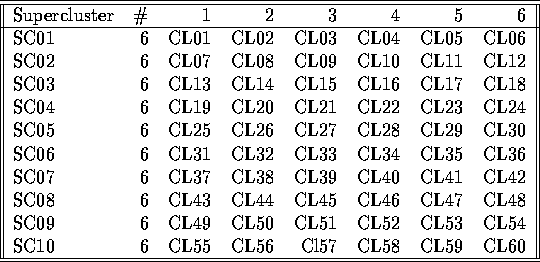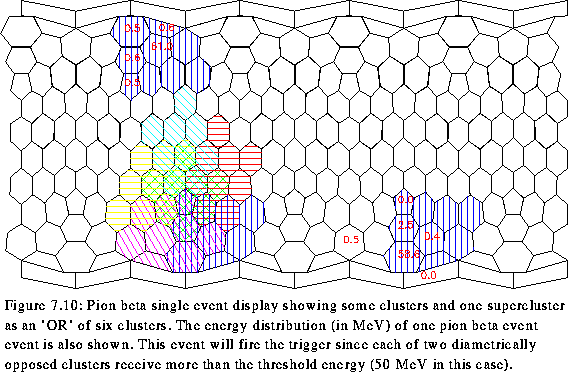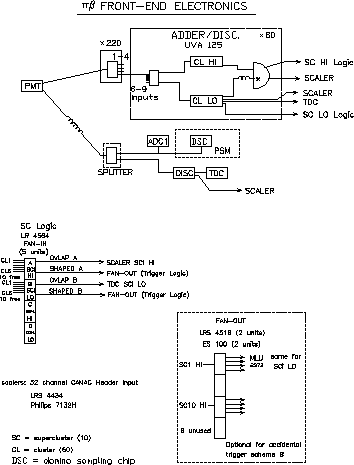



Next: Nomenclature
Up: Granularity of the
Previous: Granularity

Table: Cluster definitions for the pion beta experiment. There are
sixty overlapping clusters in the calorimeter. Each of which contains nine elements.
Shown here are the first thirty. The rest are displayed in
table  . The first six clusters make a supercluster; the next
six another supercluster, and so on. The definitions of the superclusters are
presented in table
. The first six clusters make a supercluster; the next
six another supercluster, and so on. The definitions of the superclusters are
presented in table  .
.

Table: The rest of the sixty clusters. They were designed such that each
module is shared at most by three overlapping clusters.

Table: The definition of the superclusters as the ``OR''
of clusters named CL01 through CL60. Therefore, a supercluster fires if at least one
of its cluster fires. A cluster fires if the summed energy of its modules is greater
the threshold.
There are sixty overlapping clusters each of which comprises nine calorimeter
modules. One type of clusters is centered around a pentagon and five different
types of clusters are centered around each of the hexagon B's. As explained in
section 6.2, each pentagon has associated with it,
five hexagon A's, five hexagon B's, five hexagon C's, four hexagon D's, one
HD1, one HD2, one VT1 and one VT2. Therefore, at the position of a pentagon,
six clusters can be identified: one around that pentagon itself and five
around the five hexagon B's associated with that pentagon. The rest of the
clusters follow from the geodesic subdivisions by propagating the six clusters
throughout the entire calorimeter.

The six clusters around a pentagon and the associated hexagon B's
form a supercluster. Therefore, there are ten such superclusters in the
calorimeter and in the trigger, a supercluster is the ``OR'' of six clusters.
Some clusters and a supercluster are shown in figure 7.10 together with the
energy distribution within the calorimeter of one pion beta decay event. The
clustering scheme as it translates into the pion beta trigger electronics is
illustrated in figure  .
.
The  trigger requires the coincidence of two showers
within
trigger requires the coincidence of two showers
within  inside a valid DPG; each shower energy must exceed the
threshold and they must occur in two diametrically opposed superclusters.
Beside the 4-fold Michel accidental coincidences, the only competing
inside a valid DPG; each shower energy must exceed the
threshold and they must occur in two diametrically opposed superclusters.
Beside the 4-fold Michel accidental coincidences, the only competing  decay channel in this trigger is
decay channel in this trigger is  .
.

Figure: The clustering method in
the front-end electronics. Two identical signals are extracted from the PMT. One of the
signal goes to the cluster electronics where it may be split up to four times. The
clusters are formed at the ADDER which produces a high and low discrimination outputs.
The outputs are then sent to the supercluster electronics.
However, a cut on neutrals in the plastic veto detector (see figure  ) will
significantly reduce the
) will
significantly reduce the  contribution,
leaving a clean
contribution,
leaving a clean  signal. On the other hand,
the
signal. On the other hand,
the  trigger requires the presence of a single
shower, also within the DPG, occurring in only one supercluster. As a result,
the
trigger requires the presence of a single
shower, also within the DPG, occurring in only one supercluster. As a result,
the  trigger is more susceptible to accidental
coincidences of Michel events. Although the background can be cut away in an
off-line analysis, the trigger must be sufficiently selective and free of bias.
For that reason, a fast pile-up rejection circuit will be implemented as well
as a software pretrigger involving MWPC information. One can also reduce the
cluster size from 9 to 3 to enhance the selectivity of single-arm events.
In addition to the two triggers described above, there will be a cosmic ray
trigger, a more delayed pion gate (DPG') trigger and on-line energy calibration
procedure: in the absence of beam, a laser light will be distributed
periodically to all detector modules, providing an on-line energy calibration
for the entire detector system. The realization of the various event triggers
are shown in figure
trigger is more susceptible to accidental
coincidences of Michel events. Although the background can be cut away in an
off-line analysis, the trigger must be sufficiently selective and free of bias.
For that reason, a fast pile-up rejection circuit will be implemented as well
as a software pretrigger involving MWPC information. One can also reduce the
cluster size from 9 to 3 to enhance the selectivity of single-arm events.
In addition to the two triggers described above, there will be a cosmic ray
trigger, a more delayed pion gate (DPG') trigger and on-line energy calibration
procedure: in the absence of beam, a laser light will be distributed
periodically to all detector modules, providing an on-line energy calibration
for the entire detector system. The realization of the various event triggers
are shown in figure  .
.




Next: Nomenclature
Up: Granularity of the
Previous: Granularity
Bernward Krause
Mon Jan 15 14:57:06 MET 1996

 . The first six clusters make a supercluster; the next
six another supercluster, and so on. The definitions of the superclusters are
presented in table
. The first six clusters make a supercluster; the next
six another supercluster, and so on. The definitions of the superclusters are
presented in table  .
.






 trigger requires the coincidence of two showers
within
trigger requires the coincidence of two showers
within  inside a valid DPG; each shower energy must exceed the
threshold and they must occur in two diametrically opposed superclusters.
Beside the 4-fold Michel accidental coincidences, the only competing
inside a valid DPG; each shower energy must exceed the
threshold and they must occur in two diametrically opposed superclusters.
Beside the 4-fold Michel accidental coincidences, the only competing  decay channel in this trigger is
decay channel in this trigger is  .
.

 contribution,
leaving a clean
contribution,
leaving a clean  signal. On the other hand,
the
signal. On the other hand,
the  trigger requires the presence of a single
shower, also within the DPG, occurring in only one supercluster. As a result,
the
trigger requires the presence of a single
shower, also within the DPG, occurring in only one supercluster. As a result,
the  trigger is more susceptible to accidental
coincidences of Michel events. Although the background can be cut away in an
off-line analysis, the trigger must be sufficiently selective and free of bias.
For that reason, a fast pile-up rejection circuit will be implemented as well
as a software pretrigger involving MWPC information. One can also reduce the
cluster size from 9 to 3 to enhance the selectivity of single-arm events.
In addition to the two triggers described above, there will be a cosmic ray
trigger, a more delayed pion gate (DPG') trigger and on-line energy calibration
procedure: in the absence of beam, a laser light will be distributed
periodically to all detector modules, providing an on-line energy calibration
for the entire detector system. The realization of the various event triggers
are shown in figure
trigger is more susceptible to accidental
coincidences of Michel events. Although the background can be cut away in an
off-line analysis, the trigger must be sufficiently selective and free of bias.
For that reason, a fast pile-up rejection circuit will be implemented as well
as a software pretrigger involving MWPC information. One can also reduce the
cluster size from 9 to 3 to enhance the selectivity of single-arm events.
In addition to the two triggers described above, there will be a cosmic ray
trigger, a more delayed pion gate (DPG') trigger and on-line energy calibration
procedure: in the absence of beam, a laser light will be distributed
periodically to all detector modules, providing an on-line energy calibration
for the entire detector system. The realization of the various event triggers
are shown in figure